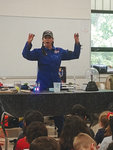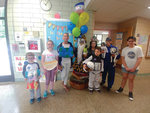By JEN COWART During Woodridge Elementary School's Reading Week the students had the opportunity to learn more about space travel and the solar system with a variety of guest speakers, presenters and readers from throughout the Cranston community. A"
This item is available in full to subscribers.
We have recently launched a new and improved website. To continue reading, you will need to either log into your subscriber account, or purchase a new subscription.
If you are a current print subscriber, you can set up a free website account by clicking here.
Otherwise, click here to view your options for subscribing.
Please log in to continue |
|


During Woodridge Elementary School’s Reading Week the students had the opportunity to learn more about space travel and the solar system with a variety of guest speakers, presenters and readers from throughout the Cranston community.
“A Universe of Stories” was this year’s theme, and it encompassed all things space related.
On Tuesday, May 28 Renee Gamba and her Jack Russell terrier, Astro-Dash, visited the school for a presentation about space, space travel and working for NASA.
Gamba is the director at the Museum of Natural History and Cormack Planetarium in Providence. She is also the outreach director for the Krupowicz Planetarium at Gaudet Middle School in Middletown. As a NASA Solar System Ambassador, she has participated in a wide variety of NASA offerings and opportunities, experiences that she has brought back to students all across Rhode Island through her presentations and exhibits at the museum.
“Besides being an astronaut, there are many other people who go into space,” Gamba told the students during her introduction. “There are engineers, people who sew fabric inside the space shuttle and veterinarians that take care of the animals that go into space. There are people living in space right now on the International Space Station, which is an orbiting laboratory.”
Gamba showed the students a model of the solar system and talked about the eight planets and gravity. She explained the impact that living in space for a period of time can have on an individual.
“One astronaut lived in space for 340 days, almost a year, and it was the longest time any human has lived in space,” she said. “He was an identical twin and his twin brother stayed on Earth. When he returned from space, he needed help getting out of the space ship. His sight and the shape of his eyeballs had changed permanently and he said it was harder to get used to being back on Earth than it was getting used to being in space.”
During her presentation, Gamba showed Luciana, the American Girl doll who went to a space camp, and she told the students that July 20, 2019, is the 50th anniversary of the date that humans set foot on the moon.
Throughout her interactive presentation, Gamba asked the students to think about life in space and the things that one would need to consider if living in space, including the protective gear needed to protect from heat, light and energy, and things that might happen while out in space, such as a meteorite passing by. She explained that those who are working on a space station often work for nine hours at a time.
With the help of student volunteers, and some earthly supplies resembling space gear, Gamba modeled what it is like to do work with protective space gear on one’s hands. She also showed the students the polymer bonding material that is used in the maximum absorbency garment that astronauts need in order to go to the bathroom.
“It’s basically an astronaut diaper,” she told the students. “We use a lot of the things that we have to help us on Earth to help us in space.”
Gamba talked to the students about the years of training that one must go through in order to be ready to go into space and the large number of applicants who apply for the job of an astronaut.
“Being an astronaut is just one tiny piece of space travel,” she said. “We need lots of different people when we think about going into space. We need geologists and people to be at Mission Control. We need citizens to help contribute and be involved.”
As Gamba concluded her presentation, she told the students that they could very well be involved in the study of space and in future space travel.
“Someone in this room will likely be a part of space missions back to the moon and to Mars,” she said.
Comments
No comments on this item Please log in to comment by clicking here